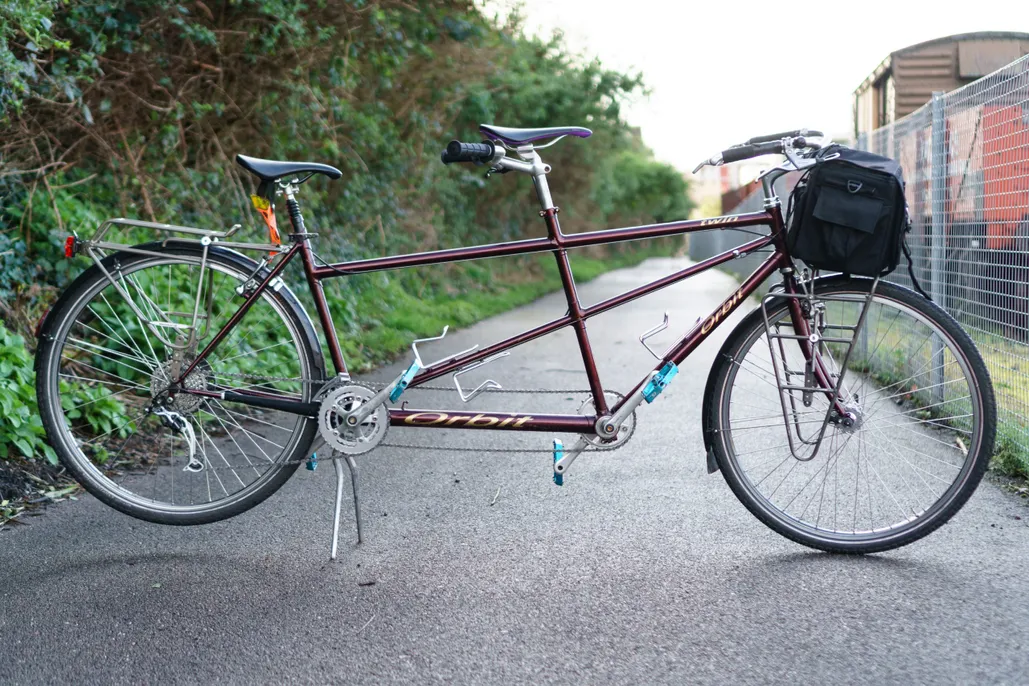A tandem bike works by connecting two sets of pedals to a single chain and gear system. The riders synchronize their pedaling to propel the bike forward together.
Tandem bikes are a unique type of bicycle designed for two riders. With a longer frame and two saddles, the bike allows two individuals to share the effort of pedaling. By working in unison, both riders can generate power and control the movement of the bike.
Tandem bikes are often used for recreational cycling, as well as for visually impaired or elderly riders who may need assistance. Understanding how a tandem bike works can help riders appreciate the cooperative effort required to operate this distinctive mode of transportation.

Credit: www.earthridercycling.com
Design Of Tandem Bikes
When it comes to tandem bikes, the design plays a crucial role in determining how these bikes work. The design of tandem bikes is unique and caters to the needs of two riders. In this section, we will explore the design elements that make tandem bikes a remarkable example of engineering and collaboration.
Frame Structure
The frame structure of tandem bikes is built to accommodate two riders. It consists of a long central beam that connects the front and rear wheels. The frame is typically made of lightweight materials such as aluminum or carbon fiber, ensuring durability and maneuverability. The length of the frame allows for a longer wheelbase, which contributes to stability, especially when riding at high speeds.
Tandem bikes often have an extended stoker/elevated handlebar stem, which helps the rear rider maintain a comfortable and ergonomic riding posture. This design feature ensures that both riders can effectively communicate and coordinate their movements.
Seating Arrangement
The seating arrangement in tandem bikes is designed to optimize balance and weight distribution. The front rider, also known as the captain, sits in the front position and controls the steering and braking. The rear rider, referred to as the stoker, sits behind the captain and contributes to pedaling power.
The seating arrangement influences the overall dynamics of the bike. Since the majority of the weight is usually at the back, tandem bikes are more stable when both riders are seated. However, some tandem bikes allow the stoker to stand while the captain remains seated, which can be beneficial in certain situations such as climbing steep hills.
Additionally, some tandem bikes have adjustable handlebars and seat positions to accommodate riders of different heights. This design flexibility caters to riders with varying body proportions, ensuring a comfortable and enjoyable riding experience for all.
Mechanism Behind Tandem Bikes
A tandem bike is a unique bicycle designed to be ridden by two or more people. It offers a fun and efficient way for individuals to enjoy bike rides together. Let’s explore the fascinating mechanism behind tandem bikes.
Pedaling System
In a tandem bike, the pedaling system is a crucial component that allows both riders to contribute their power to propel the bike forward. Unlike regular bicycles, tandem bikes feature two sets of pedals, one for each rider. These pedals are connected by a drivetrain, typically through a chain or belt mechanism.
The pedaling system enables both riders to pedal in sync, increasing the efficiency and speed of the bike. The riders must coordinate their effort and communicate to ensure a smooth pedaling motion. This synchronization is key to maintaining balance and enjoying a comfortable ride.
Steering And Braking
When it comes to steering, a tandem bike operates similarly to a regular bicycle. The front rider, known as the captain, is responsible for steering the bike. They control the handlebars, allowing them to maneuver the tandem bike as desired. The rear rider, known as the stoker, must communicate with the captain to coordinate turns and maintain balance.
In terms of braking, tandem bikes typically use dual braking systems, just like regular bicycles. Each rider has their own set of brake levers, controlling separate brake systems for both front and rear wheels. This redundancy ensures safety and provides additional control when coming to a stop or during emergencies.
Riding A Tandem Bike
Riding a tandem bike involves two riders working together to pedal and steer the bike as one unit. The coordination and communication between riders are essential for a smooth and enjoyable ride.
Communication Between Riders
Clear communication between tandem riders is crucial for a safe and efficient ride. Some common forms of communication include:
- Use of verbal cues to coordinate pedaling and braking.
- Non-verbal signals such as tapping the handlebars to indicate turning.
- Establishing a rhythm and syncing pedaling motions to maintain stability.
Challenges And Tips
Riding a tandem bike comes with its unique challenges, but with practice and the following tips, you can overcome them:
- Practice: Spend time practicing in a safe area to get accustomed to the coordination required.
- Trust: Trust your partner and communicate openly to ensure a harmonious ride.
- Balancing: Distribute weight evenly to maintain balance and stability.
- Anticipate Movements: Anticipate your partner’s movements to adjust your actions accordingly.
- Enjoy the Experience: Embrace the teamwork aspect of tandem riding and have fun together.

Credit: www.bikeradar.com
Maintenance And Safety
Riding a tandem bike can be a joyous and exhilarating experience, but ensuring its proper maintenance and practicing safety precautions is crucial for a smooth and secure ride. By conducting regular inspections and following essential safety measures, you can ensure your tandem bike provides a safe and enjoyable riding experience. Let’s delve into the key aspects of tandem bike maintenance and safety in more detail.
Regular Inspections
Regular inspections are vital to ensure that your tandem bike remains in optimal condition. Check the following components:
- Frame and Fork: Look for any signs of cracks, dents, or damage. Ensure that the frame joints are secure.
- Brakes: Inspect the brake pads for wear and tear. Verify that the braking system is functioning effectively.
- Chain and Drivetrain: Clean and lubricate the chain regularly. Check for any signs of rust or excessive wear.
- Tires and Wheels: Examine the tire pressure and tread. Ensure that the wheels are true and the spokes are properly tensioned.
Safety Precautions
When riding a tandem bike, it’s essential to adhere to specific safety precautions to mitigate the risk of accidents and ensure a secure riding experience. Here are some key safety measures to practice:
- Communicate: Establish clear communication with your riding partner to synchronize movements and anticipate maneuvers.
- Wear Helmets: Both riders should always wear properly fitted helmets to protect themselves in case of an unexpected fall or collision.
- Observe Traffic Rules: Follow traffic signals, signs, and regulations at all times to enhance safety on the road.
- Maintain Balance: Proper coordination and balance between both riders is crucial for stability and control of the tandem bike.
Tandem Biking Community
Tandem biking is not just about the thrill of pedaling together; it’s also about being part of a vibrant and supportive community. Whether you’re new to tandem biking or a seasoned rider, the tandem biking community offers a welcoming environment for cyclists of all levels. From group riding events to the benefits of riding in pairs, there’s a lot to explore and enjoy within this tight-knit community.
Group Riding Events
Tandem biking enthusiasts often organize group riding events to bring together like-minded individuals who share a passion for cycling. These events provide a fantastic opportunity to connect with other tandem riders, exchange tips and tricks, and enjoy the camaraderie of cycling with others. From leisurely rides through scenic routes to challenging terrain, group riding events offer a variety of experiences for tandem biking enthusiasts.
Benefits Of Riding In Pairs
Riding in pairs offers a plethora of benefits, not only in terms of physical exercise but also in fostering a sense of teamwork and mutual support. Tandem biking encourages communication, trust, and coordination, as both riders work together to navigate and conquer different terrains. Additionally, riding in pairs allows for a more efficient cycling experience as riders can take turns leading and drafting, resulting in a smoother and ultimately less tiring ride.

Credit: www.cyclingabout.com
Tandem Bikes For Different Needs
Tandem bikes cater to various individuals with different requirements, allowing them to enjoy the thrill of cycling together. These specialized bikes promote inclusivity and enable people with diverse needs to experience the joy of riding a bike in tandem.
Tandem Bikes For Visually Impaired
Tandem bikes for visually impaired individuals offer a unique way to engage in cycling. The rider with sight acts as the pilot, providing guidance and coordination, while the visually impaired individual enjoys the ride, trusting their partner’s directions.
Tandem Bikes For Special Needs Individuals
Tandem bikes for special needs individuals are designed to accommodate various physical and cognitive challenges. These bikes provide a safe and supportive cycling experience, allowing individuals with special needs to participate in an enjoyable outdoor activity alongside a partner.
Frequently Asked Questions Of How Does Tandem Bike Work
Do Both Riders Have To Pedal On A Tandem Bike?
Yes, both riders need to pedal on a tandem bike.
Is It Easier To Ride A Tandem Bike?
Yes, riding a tandem bike is generally easier because two people can share the effort of pedaling. It allows for better balance and stability, making it easier to control the bike. Additionally, the weight of two riders can help with momentum and climbing hills.
Who Balances In A Tandem Bike?
Both riders contribute to balancing a tandem bike by coordinating their movements and adjusting their weight distribution.
Can Someone Who Doesn’t Know How To Ride A Bike Ride A Tandem Bike?
Yes, someone who doesn’t know how to ride a bike can ride a tandem bike with a partner who can.
Conclusion
In exploring how tandem bikes work, we’ve unveiled a unique mode of cycling. It’s a shared adventure, where communication and teamwork are key. Whether you’re a novice or a seasoned rider, the tandem bike offers a fun and engaging way to enjoy the great outdoors together.
Ready to ride?


